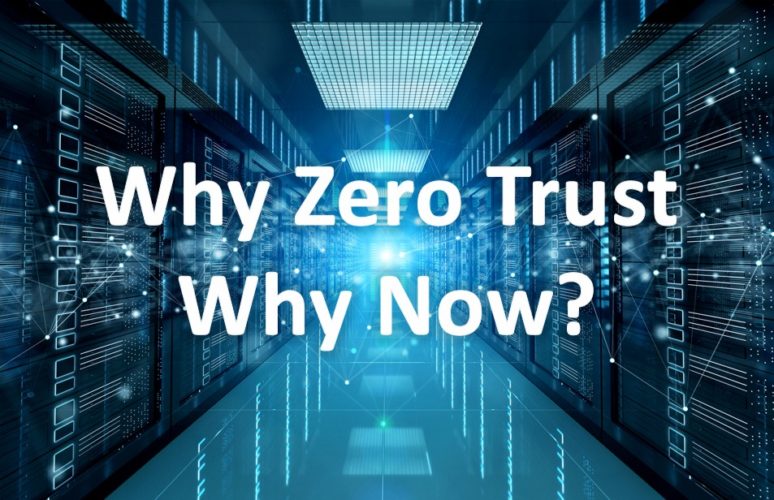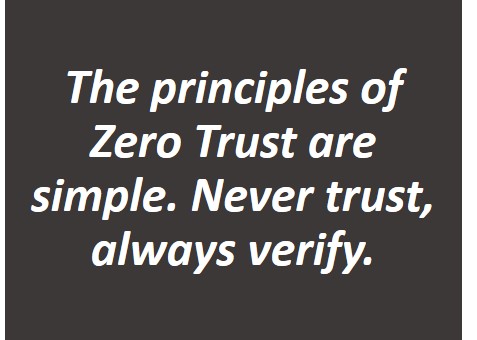
The principle behind zero trust is very simple – never trust and always verify every transaction. This protects your organization in ways that other models cannot.
Why Zero Trust and Why Now?
Estimated reading time: 4 minutes
Concept of Zero Trust
The concept of a Zero Trust (ZT) cybersecurity architecture has been around for more than a decade. However, adoption didn’t really begin to take hold until the past couple of years. As with many technological innovations, it hasn’t always been clear just what Zero Trust is all about, and more importantly how to implement Zero Trust easily and cost-effectively.
The principles of Zero Trust are simple. Never trust, always verify. In practice, that means each user must be verified before access is granted to any resource. Every request from every user, inside or outside of your perimeter security must be authenticated, authorized and encrypted, in real time.
How Zero Trust Protects Your Organization
This protects your organization in ways other models cannot. It stops malware from entering your network. It gives remote workers more protection without affecting productivity. It simplifies the management of security operations centers with enhanced automation, and it extends visibility into potential threats to improve proactive remediation and response.
Whether your organization is already deploying Zero Trust or the term is completely new to you, it is important to understand just what ZT is all about and how it can protect your organization and how to implement it most effectively.
In macro terminology, Zero Trust changes the concept of perimeter security which is based on location to a new more secure model based on user identity and authorized access. This is a much more relevant security model in today’s era of cloud computing, remote workers, and digital transformation. Zero Trust is truly a game-changer in helping to reduce complexity, lower costs, decrease the number of cybersecurity tools and address the growing shortage of skilled cybersecurity personnel.
The Zero Trust Journey
As organizations have experienced the benefits of Zero Trust, usage is growing rapidly, to the point where ZT is fast becoming the new norm in cybersecurity conversations and expectations. Deployments are growing at a compound annual rate of 17% and the overall market is expected to reach $38 Billion by 2025.
Why Zero Trust?
One of the biggest reasons for this growth is that Zero Trust can now be deployed more easily, seamlessly, and cost-effectively as part of an end-to-end security architecture. For many organizations, this mitigates the big issue of how to implement ZT. It allows IT to seamlessly integrate components such as identity policy and enforcement as part of their existing, widely-used software solutions, resulting in reduced capital overhead and simplified deployment.
Perhaps just as important in driving Zero Trust growth, business leaders are now recognizing and embracing the intrinsic and significant value of ZT when it comes to protecting their organizations from breaches and malicious cybersecurity attacks. Part of this awareness is a result of the current pandemic and the urgent need to scale and secure remote worker access.
Nearly 40% of organizations adopting Zero Trust have accelerated their efforts because of the pandemic. The primary reasons for this are to reduce the risk of remote work and insider threats, mitigate third-party risk and manage cloud risk.
Zero Trust Implementation
In reality, Zero Trust is a new IT journey. The most effective strategy is to roll out ZT in stages so that IT and cybersecurity teams, as well as users, gain knowledge and experience. The three key pillars can be identified as the following:
- Zero Trust Data Access.
- Zero Trust Network Access.
- Zero Trust Application Access.
Getting Started
Many organizations start with specific applications, data assets, or classes of users. They want to protect their most vulnerable assets – their data and their users. For example, with more people working remotely, users with the most widespread access privileges may be vulnerable to additional risks from unsecured home networks and devices that may be used for both business and personal applications.
Another critical factor in implementing Zero Trust is the ability to leverage existing solutions to make the transition more seamless and less costly. Qnext in particular has been a leader in leveraging ZT capabilities across its solution – FileFlex Enterprise. This new product is set to simplify secure Zero Trust Data Access across corporate hybrid infrastructures. FileFlex Enterprise does this by providing an end-to-end Zero Trust security model for seamless data access, sharing, and collaboration.
FileFlex Enterprise Accelerates Zero Trust Deployments
In real-world use cases, an end-to-end security strategy using Zero Trust Data Access technologies like FileFlex Enterprise has enabled customers across the globe to simplify and streamline deployments and empower their remote workforces.
Underlying Principles of Zero Trust Data Access
The underlying principles of Zero Trust Data Access are:
- Granting micro-segmented access to data (as opposed to protecting a perimeter).
- Every transaction and every user is authorized and authenticated, every time.
- Access and Sharing policies can be customized on a user-by-user and a file-by-file basis.
- All transactions by all users are tracked and monitored.
Taking the Next Step
Now is the time to explore, expand or accelerate Zero Trust initiatives. The shift to remote work is not going away no matter what happens with the current pandemic. And adversaries have been even more aggressive in seeking to exploit the new security vulnerabilities that the massive remote workforce is bringing.
Zero Trust not only delivers significant improvements in security but also reduces costs and complexity while providing more peace of mind for business and IT leaders, cybersecurity teams, and end-users.
Now It is Easier Than Ever
Fortunately, the path to Zero Trust is much easier than ever. With the FileFlex Enterprise Zero Trust Data Access solution organizations can move at their own pace towards building an end-to-end Zero Trust architecture, one step at a time. With FileFlex Enterprise as the first step, you start by protecting your data – y our most valuable asset.
For more information on how your organization can adopt Zero Trust, please visit www.fileflex.com or check out How to Protect Your Data with Zero Trust Data Access and find out where you are in your journey of identity, devices, apps, infrastructure, and data security and what the best next step is to establish a trust-based access strategy.[/vc_column_text][/vc_column][/vc_row]
Learn More About FileFlex Sign Up for a Free Trial